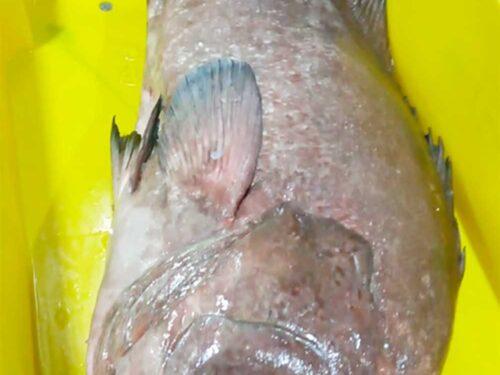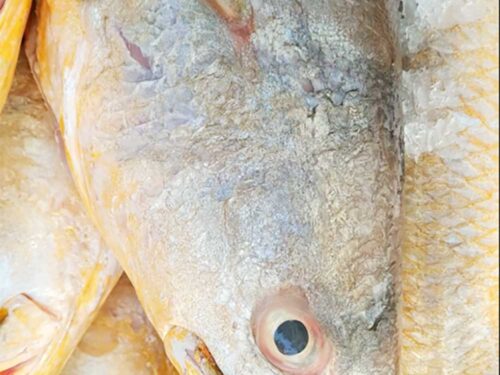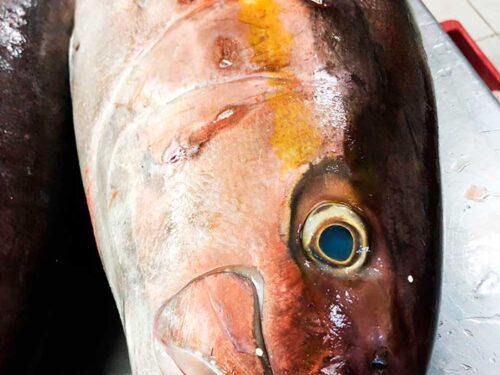Description
Mutton Snapper is a seafood delicacy appreciated by chefs around the world. They are native to the Atlantic coastal waters of the Americas from Massachusetts to southern Brazil, together with the Caribbean Sea and the Gulf of Mexico.
In brazil these fish tend to be most abundant off north east coast of the country (Ceara, Bahia). An olive color, progressing from darker to lighter in color from top to bottom, distinguish them from lane snappers. Notably, the small blue streaks on the face and the pointed anal and dorsal fins.
They inhabit reef environments, with adults present in areas with rock or coral, whereas juveniles happen in sandy habitats with plentiful weed progress.
Size:
- Maturity:Lm 43.8, range 11 – 15 inches
- Max length: 36.9 inches TL male/unsexed;
- Common length: 19.6 inches TL male/unsexed;
- Max. published weight: 34.3 lbs;
- Max. reported age: 29 years;
Where can Mutton snappers be found?
They’re are widespread within the Caribbean and often found in tropical waters such as the Bahamas. As juveniles, mutton snapper shelters in seagrass and mangrove habitats. They likes structure, and tend to move offshore into deeper water as it ages.
How does Mutton snapper look like?
There is a black spot on them between the lateral line and the spiny part of the dorsal fin. There is a pair of blue stripes beneath the eyes and the higher one continues on to the operculum. The caudal fin has a black margin. When the fish is resting it has 10 to 12 dark vertical bars on the body, these merge into a solid colour when the fish is swimming.[6] The fins are red. Small juveniles, around 15 mm (0.59 in) in length, have transparent fins and yellowish brown bands on the body,[5] larger juveniles are marked with yellow bands on their body and a more prominent black spot than the adults.[6] This fish attains a maximum total length of 94 cm (37 in), although 50 cm (20 in) is more typical, and the maximum published weight is 15.6 kg (34 lb). Matures include blue lines below and behind the eyes with a small black spot present on both sides.
How does Mutton snapper behave?
The mutton snapper is a predatory species which changes its diet during its life cycle. The larvae feeds on plankton near the surface of the sea, when they settle to live in the turtle grass beds they eat larger items of plankton and small invertebrates. As they grow they begin to feed on crustaceans, gastropods and smaller fishes, like grunts and mullets. They feed throughout the day, picking at prey. The body colour changes depending on the method of feeding, the dark barred pattern being adopted when feeding near the bottom.
Mutton snapper is a solitary fish, their eggs and larvae are pelagic, floating in the water column until they settle in shallow inshore waters.
Muton snappers spawn in aggregations from February to August depending on location and water temperature.
Mutton Snapepr: Health benefits
Aids in a healthy metabolism: Eating Mutton Snapper helps with weight management by increasing the body’s metabolism with its high concentration of potassium. Also, the potassium in mutton snappers activates the enzymes needed for energy metabolism. A diet lacking in adequate potassium levels may increase your chance of stroke, high blood pressure, osteoporosis and kidney stones.
Healthy Fats: The mutton snapper is rich in Omega-3 fatty acids. Thanks to those fatty acids, The American Heart Association says eating fish regularly may significantly decrease your risk of heart disease, atherosclerosis and high blood cholesterol.
Easy Digestion: A smooth digestion equals a good food absorbing process. The nutrients in Mutton Snappers aid in inflammation and increase the food absorption to the blood stream and other organs, leaving you with smooth digestion and decreased risk of stomach problems.
Cognitive Stimulation: All the healthy nutrients in the Mutton Snapper (such as Vitamin A, selenium, Omega-3 fatty acids and potassium) are why the fish is considered brain food! Consuming fish like the Mutton Snapper will stimulate cognitive functions and boost the health of the nervous system.
Increases White blood cells + Thyroid health: The Mutton snapper contains nearly 70% of the amount of selenium recommended in a 2,000 calorie diet. Not only is it a huge supporter of white blood cell function (Increases the number of white blood cells produced by the body) but it is also required for the Thyroid gland to work properly. Selenium is an extremely important antioxidant that we don’t hear enough about for its ability in preventing free radical compounds from causing DNA damage, arthritis, cancer and heart disease.
Mutton Snapper: Culinary profile
Like other species in the snapper family, mutton snapper has a lean, firm texture. It’s white flesh is tinted pink, and it has mild, sweet taste when eaten fresh.
It tastes great fried, baked, poached, grilled, broiled, or steamed. For a quick meal, you can season your snapper fillets with lemon, butter, and chilis.
Mutton Snapper videos
Mutton Snapepr nutritional facts
- Serving size:3 oz
- Calories: 85 kcal
- Total fat: 1.1 grams
- Cholesterol: 31 mg
- Protein: 17 grams
- Sodium: 54 mg
- Potassium: 354 mg
- Vitamin D: 43%
- Calcium: 2%
- Iron: 1%






Reviews
There are no reviews yet.